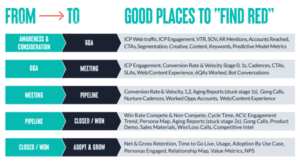Execute Your Vision: 6 Steps to Activate Your Demand Generation Plan

By Payal Parikh, Director of Client Engagement at Heinz Marketing
How many of you have seen great vision fail? And why did it fail? Well it is easy to point fingers at the vision itself or at others in the execution roles, market conditions and even some alien virus that is affecting us all.
Have you thought about certain factors most marketers fail to look at? Aligning with the business goals/revenue model, creating a culture of trust and transparency, etc.
Latané Conant (CMO at 6sense) in her new book No Forms. No Spam. No Cold Calls. has outlined 6 steps for you to roll up your sleeves and put your bold new vision into action. This provides a detailed repeatable process for creating truly customer-first, account-based, insight-driven sales and marketing programs.
- Align on a revenue operating model
- Find the red
- Design your go-to-market plan
- Execute using the 5-step account-based formula
- Inspect what you expect
- Communicate and repeat
6 Steps to Activate Your Demand Generation Plan
How do you turn your vision into ACTION?
Step 1: Align on revenue operating model
A revenue operating model is a framework for how you’re going to make money. It is not an MQL goal or an SQL goal. It’s an in-depth plan that details what you need to achieve at each stage of the marketing, sales, and customer success cycle.
Dialing in on a revenue operating model and aligning on it across the revenue side of the organization, makes sure everyone in the organization is focused on a common goal and everyone understands underlying dependencies. It ensures as a marketer you are not throwing MQLs over the wall and ‘crushing your numbers’ while overall the company is not meeting its plan. It’s about assuming responsibility throughout the funnel.
Here are some account-based metrics that are vital when creating a useful revenue operating model:
- Account win rate
- Accounts in-market
- Deal velocity
It’s important to figure out how you move your targets through your marketing funnel, and into sales. You need to look at the historical data and determine some key metrics. Like win rate, average deal size, amount of pipeline you need to create at each stage. You then apply that to your current goals. Looking at the amount of pipeline you’ve historically had at each buying stage and the revenue you’ve attained with those numbers, it’s simply a math exercise to determine how many accounts you’ll need at each buying stage in order to achieve your current revenue goals.
One benefit to a solid revenue operating model: In case of any disruption to any of the channels, you can look at the model and pivot to compensate from other channels.
Step 2: Finding the Red
How many of you monitor your KPIs on a regular basis – and see gaps? Latané refers to this process as Finding the Red – looking for spots in the plan that either aren’t performing or are at risk of falling short. The more granular you can get in identifying the red flags, the better.
You can look at a bunch of different metrics and each funnel stage to find the red. Benchmarks are a great start but even better is looking at your own historical data and setting improvements on them.
Once you are all set and have identified the key steps in your process that needs improvement, it’s time to create your go-to-market plan!
(click image to enlarge)
Step 3: Design your Go-To-Market Plan
Your GTM plan is a comprehensive plan that spells out the campaigns you need, channels you will use in order to achieve the goals you’ve established in your revenue operating model.
In order to allocate resources efficiently, Latané has laid out three tiers they use at 6sense:
- Tier 1 campaigns: Generate a ton of pipeline and revenue, drive market awareness, drive your category plan forward.
- Tier 2 campaigns: More bite-sized point-in-time projects
- Tier 3 campaigns: The bread and butter campaigns you build at a more programmatic level and accelerate pipeline. They keep running without much effort
Creating a solid GTM plan with a tiered system is a great way to hyper-prioritize what’s really important to your overall goals and strategy. When you understand your capacity, down to the exact number of campaigns per tier your team (and budget) can handle, you’re able to make sure you’re only saying yes to the absolute best campaigns that will help you meet your objectives
Step 4: Execute Using the 5-Step Account-Based Formula
- Select the best accounts
- Know about them
- Engage the right way
- Collaborate with sales
- Track real stuff
Step 5: Inspect What You Expect
Now that you have setup some campaigns, inspect each one against the goals you set earlier, see where it performed and where it didn’t, and make adjustments accordingly. There will be lessons learned along the way, nobody is perfect. That’s why you inspect and then you adjust.
Step 6: Communicate and Repeat
Transparency is key to building trust within an organization and trust within an organization is essential for success. In order for an organization to function together as a team instead of in competition with one another, it is very important to communicate openly and honestly.
Communication is key here, but so is the right technology. Marketing, sales, success leaders all looking at the exact same dashboard and working off the same data—makes a huge difference in trusting the data.
Are you interested in reading more, do you have a vision and would like to make sure it is executed well? Get your ideas and inspiration from You can order your copy at Amazon.com
Full Disclosure: 6sense is a client of Heinz Marketing

